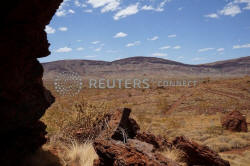Exclusive: Rio vows to preserve ancient Australian rock
shelter after outcry over caves blast
 Send a link to a friend
Send a link to a friend
 [August 31, 2020] By
Melanie Burton [August 31, 2020] By
Melanie Burton
MELBOURNE (Reuters) - Rio Tinto <RIO.AX> <RIO.L> has pledged to protect
a 43,000-year old rock shelter on the fringe of its Silvergrass iron ore
mine in Western Australia as it reviews heritage sites following outrage
over the destruction of sacred ancient caves this year.
Rio Tinto, which has state government approval to damage the site, told
the Wintawari Guruma people, its traditional owners, of its intention to
preserve the rock shelter last week, although the Wintawari say they
have yet to receive confirmation in writing.
"We will protect the site and also have mining buffer zones in place to
further ensure the site is not at risk," the world's largest iron ore
miner said in an e-mail in response to Reuters questions about the site.
The state government-approved detonation in May of caves in the same
region that showed evidence of human history stretching back 46,000
years provoked worldwide condemnation and has triggered government and
internal reviews.

Since then, Australia's biggest iron ore miners - Rio Tinto, BHP <BHP.AX>
<BHPB.L> and Fortescue Metals Group <FMG.AX> - have been reviewing
heritage sites that could be affected by mine expansions, although they
have resisted calls for a complete moratorium on sites for which they
have been granted exemptions to disturb or damage.
The 43,000-year old rock shelter was highlighted in a March 2018 report
by Scarp Archaeology as having "high archaeological significance", which
also noted the Silvergrass East area was "likely to feature more
locations of extensive antiquity."
Despite the findings of the report, Rio Tinto applied the following
April to damage the site, called SG-07-22, and consent was granted by
the state government's Minister for Aboriginal Affairs in an Aug. 15
2019-dated document that was obtained by Reuters.
"Nobody at Wintawari is ever happy to see any sites destroyed -
hopefully Rio is also coming around to that point of view," said Kathryn
Przywolnik, heritage manager for the Wintawari Guruma Aboriginal
Corporation.
[to top of second column] |

A view of the Silvergrass East rockshelter, Australia in this 2019
handout photo obtained on August 31, 2020. Kathryn Przywolnik/Handout
via REUTERS THIS IMAGE HAS BEEN SUPPLIED BY A THIRD PARTY. NO
RESALES. NO ARCHIVES

"This could be a sign of Rio reviewing its decision-making process but it's a
bit early to tell."
Since July 2010, miners have submitted more than 460 applications to disturb or
destroy sites of potential cultural significance in the region, according to
Western Australia state parliament records. All but one of those applications
were approved.
The May blasts of the sacred caves, whose traditional owners are the Puutu Kunti
Kurrama and Pinikura people, highlighted the power imbalance between miners and
Indigenous Australians who have no legal veto over development projects on their
ancestral land.
Unlike their title suggests, traditional owners donít own the land and are only
sometimes considered stakeholders in its management.
An Australian federal government inquiry that began in June has exposed
controversial clauses in miners' contracts with traditional owners that prohibit
them from publicly objecting to site destruction and that may also impede their
rights under other Australian legislation.
Rio Tinto executives are due to give further evidence before the inquiry from
late next month.
The outcry over the May blasts also became one facet of the Black Lives Matter
protests in Australia, where Aboriginal groups have long suffered higher rates
of imprisonment, unemployment and lower life expectancy.
(Reporting by Melanie Burton in Melbourne; Additional reporting by Simon Scarr
in Singapore; Editing by Edwina Gibbs)
[© 2020 Thomson Reuters. All rights
reserved.] Copyright 2020 Reuters. All rights reserved. This material may not be published,
broadcast, rewritten or redistributed.
Thompson Reuters is solely responsible for this content.
 |